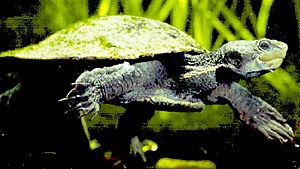Gulf snapping turtle facts for kids
Quick facts for kids Gulf snapping turtle |
|
|---|---|
 |
|
| Elseya lavarackorum | |
| Scientific classification | |
| Genus: |
Elseya
|
| Species: |
lavarackorum
|
| Synonyms | |
|
See text |
|
The Gulf snapping turtle or Lavaracks' turtle (Elseya lavarackorum) is a big freshwater turtle. It belongs to a group of turtles called "sidenecked" turtles. These turtles live only in northern Australia, specifically in northwest Queensland and northeast Northern Territory. Like other Australian snapping turtles, it usually stays in the water and only comes out to lay eggs or warm up in the sun. The Gulf snapping turtle is a herbivore, which means it mainly eats plants like Pandanus plants and figs.
Contents
What's in a Name?
The scientific name, lavarackorum, was given to honor two Australian paleontologists (scientists who study fossils). Their names are Jim Lavarack and Sue Lavarack. They were the ones who found the fossil bones of this turtle.
Turtle Family Tree
This turtle was first described in 1994. Back then, scientists thought it belonged to a different group of turtles called Emydura. This was after its fossil bones were found in a place called Riversleigh in northwest Queensland.
Later, scientists studied its bones more closely. They found out it actually belonged to the Elseya group of turtles. What's really cool is that this turtle was declared Australia's first "living fossil" freshwater turtle. This means it's a living animal that looks almost exactly like its ancient ancestors from the Pleistocene era. This discovery got a lot of attention in magazines!
Knowing where this turtle truly belonged helped scientists understand the Elseya group better. The Gulf snapping turtle gives its name to a special group of Elseya turtles found in Queensland. This group includes Elseya lavarackorum, Elseya albagula, and Elseya irwini.
Scientific Names Over Time
- Emydura lavarackorum White & Archer, 1994
- Elseya lavarackorum — Thomson, White & Georges, 1997
- Elseya lavarakorum Cann, 1998 (ex errore)
- Elseya lavackorum Georges & Thomson, 2006 (ex errore)
- Elseya dentata lavarackorum — Artner, 2008
- Elseya (Pelocomastes) lavarackorum — Thomson et al., 2015 (comb. nov.)
- Elseya (Pelocomastes) oneiros —Joseph-Ouni et al. (2020)
How to Spot a Gulf Snapping Turtle
The Gulf snapping turtle is a large turtle. It has a short neck and its shell is usually brown to dark brown. Its upper shell, called the carapace, can grow up to 35 centimeters (about 14 inches) long.
If you look at its underside, called the plastron, it's white. It has a wavy line where two parts of its plastron meet. This wavy line helps tell it apart from another turtle, the northern snapping turtle (Elseya dentata), which has a straight line there.
Where They Live
The Gulf snapping turtle lives only in rivers that flow into the Gulf of Carpentaria. This area is in the Northern Territory and Queensland in Australia. You can find them in rivers like the Nicholson and Calvert River systems in the Northern Territory. They also live in the Gregory River in Queensland.
What They Eat and Do
The Gulf snapping turtle is mostly a herbivore. This means it eats plants. Its diet includes fruits, flowers, leaves, tree bark, and the roots of Pandanus plants. Young turtles also eat insect larvae. Figs are a very important food for these turtles. Even though they mostly eat plants, they can sometimes be caught using meat as bait.
Reproduction
Female Gulf snapping turtles lay their eggs in the soil. They usually choose a spot close to the water's edge.
Protecting the Gulf Snapping Turtle
The Gulf snapping turtle is considered an Endangered animal by the Australian government. It is also listed as Vulnerable in Queensland and of Least Concern in the Northern Territory.
There are several things that threaten these turtles. Wild animals like pigs can disturb their nesting sites. Cattle grazing and drinking water can also harm their habitat. Changes to water flow and climate change are also big concerns. Sometimes, these turtles can also get caught in fishing nets.

